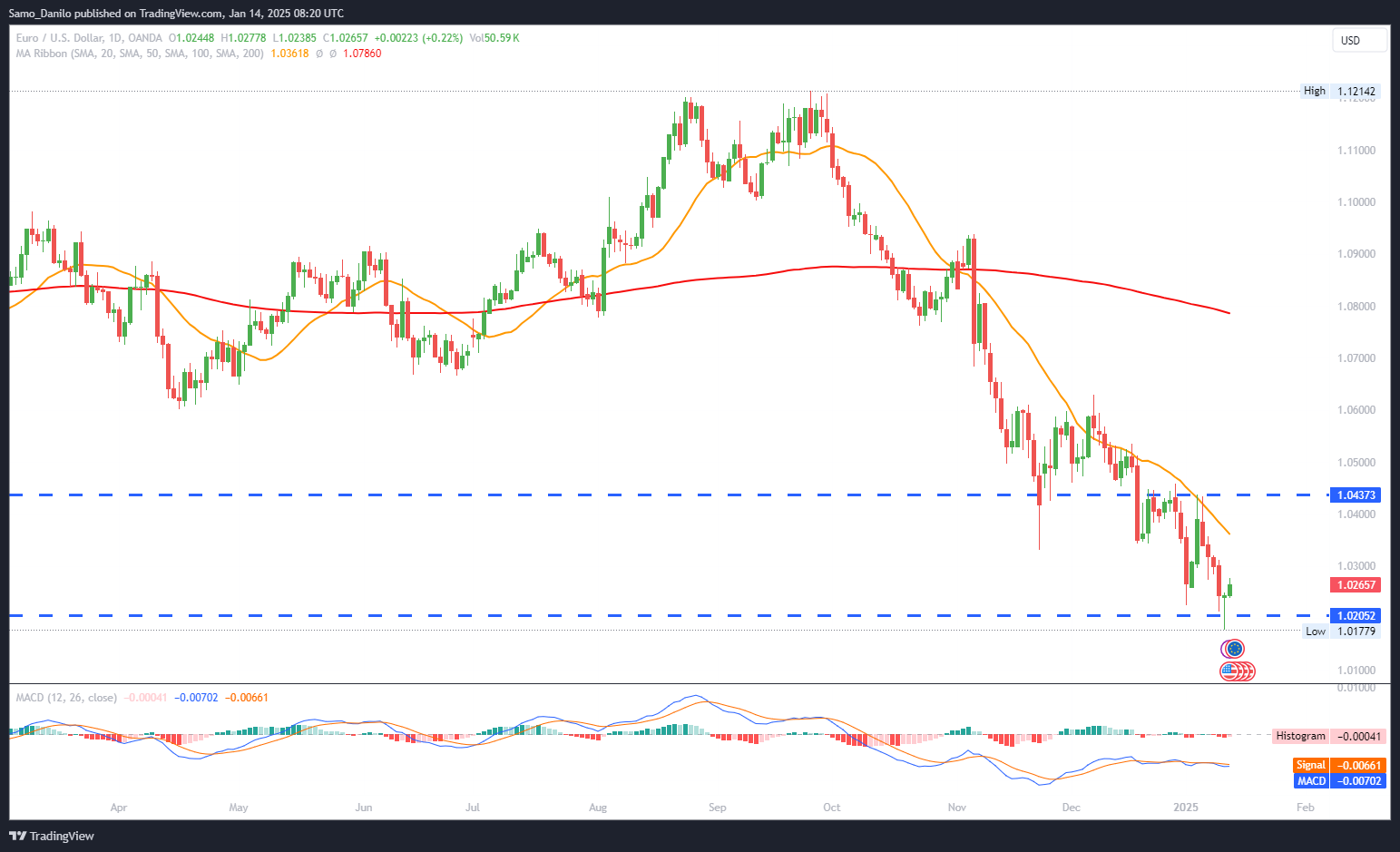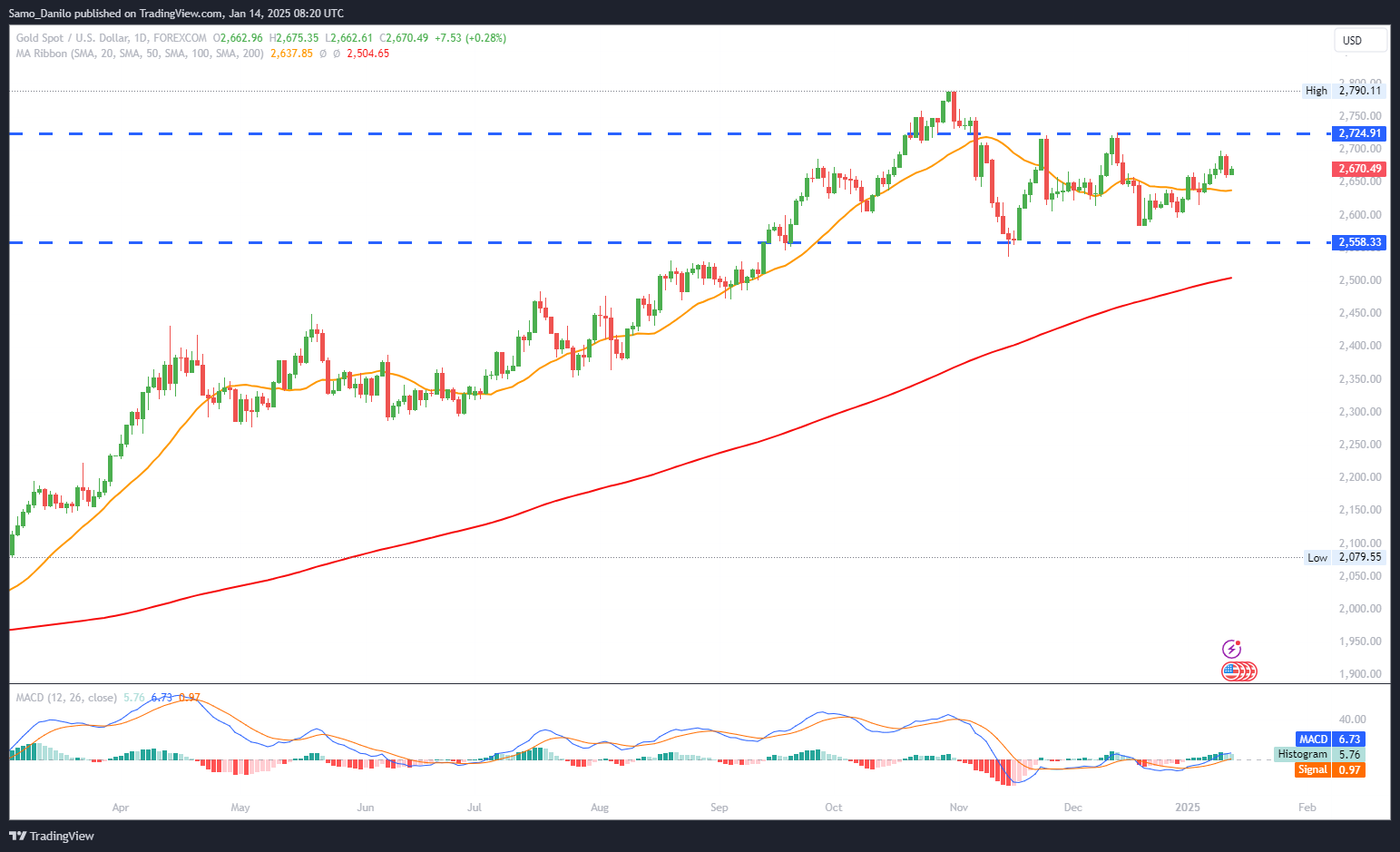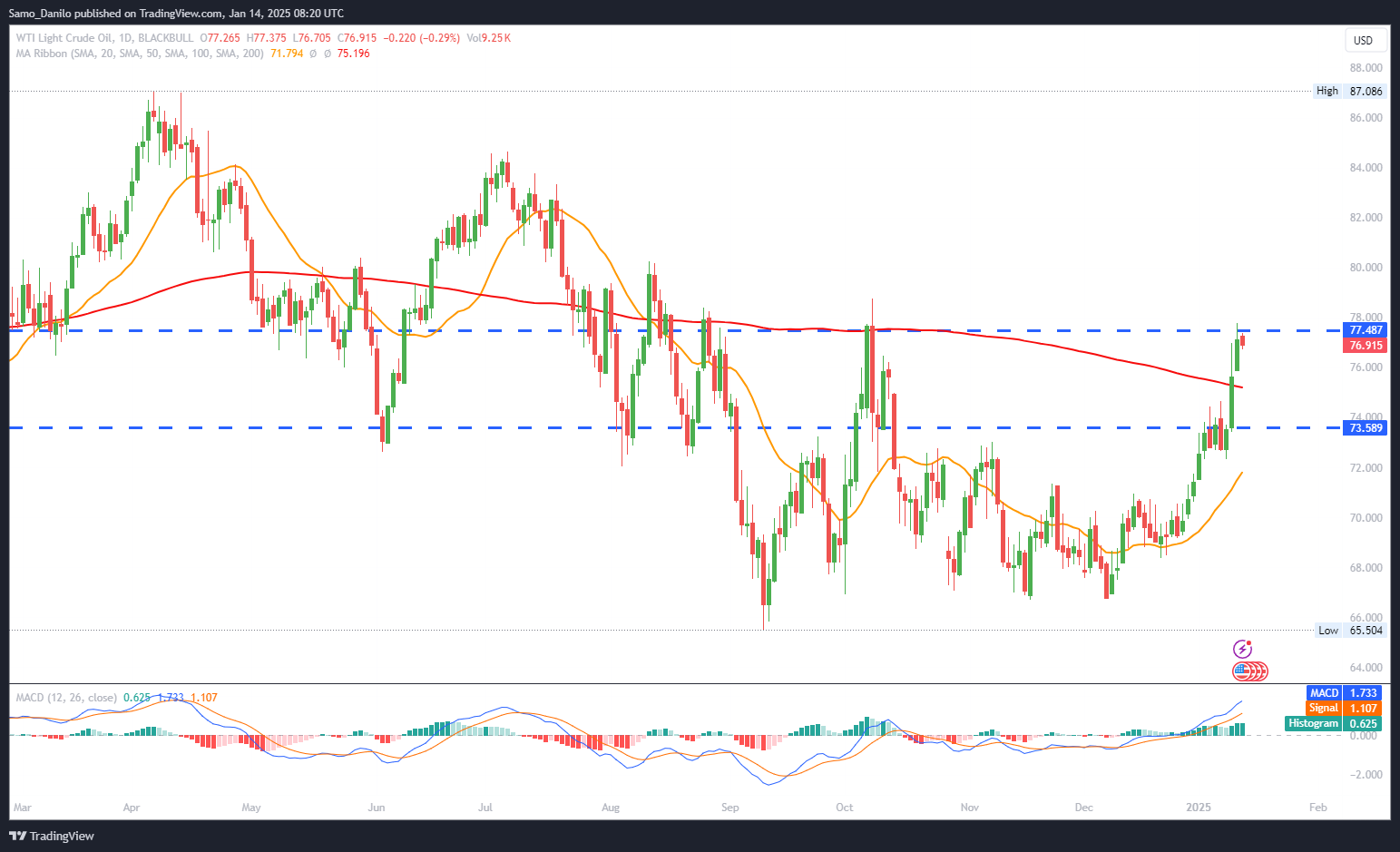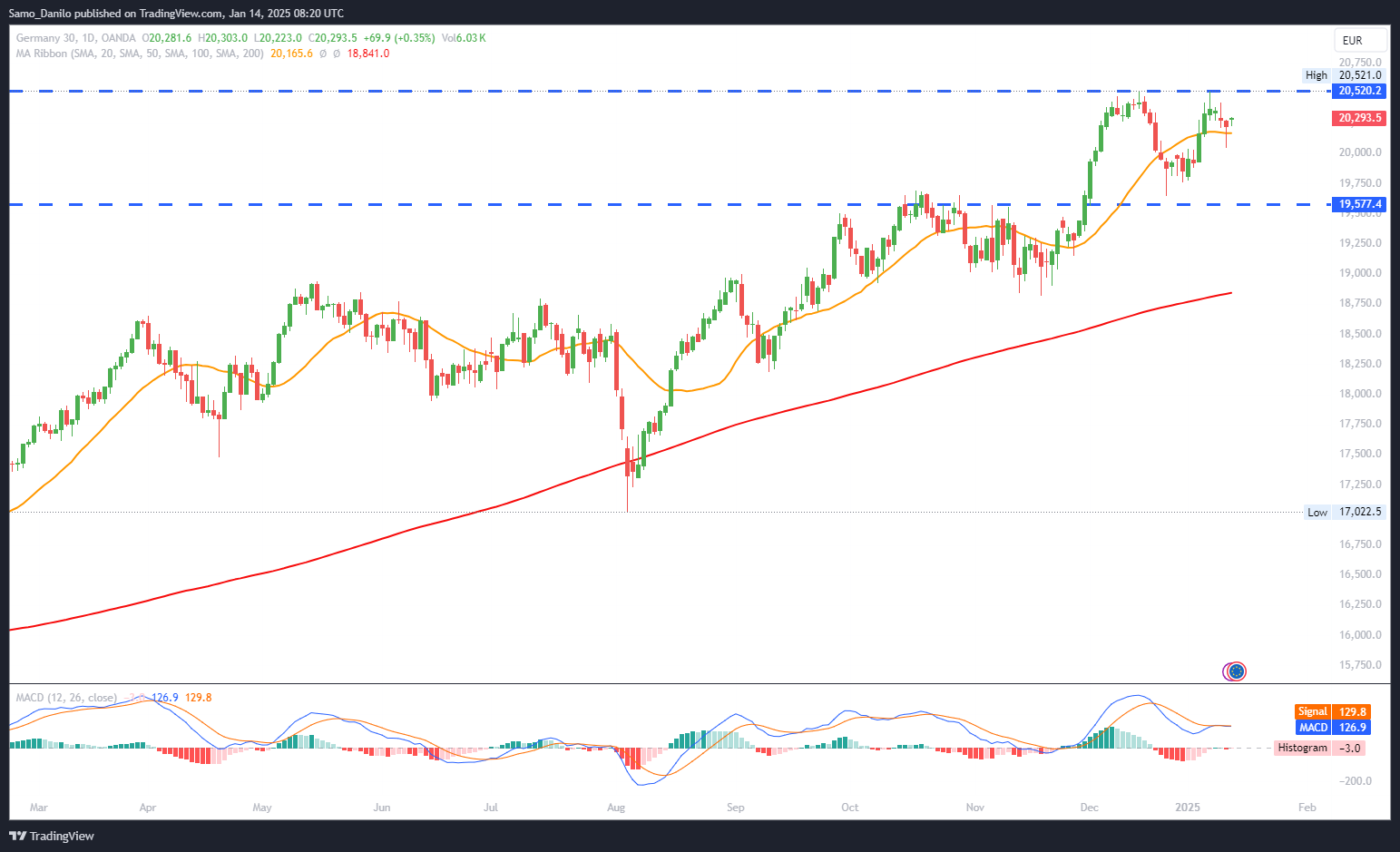EURUSD
- EUR/USD Price: After five consecutive sessions of losses, EUR/USD stabilizes around 1.0250 during Tuesday's European trading hours. This marks a pause in the recent bearish trend as traders assess new developments.
- Euro Struggles: The shared currency remains under pressure due to the European Central Bank’s (ECB) dovish stance and growing concerns about economic weakness in the Eurozone. These factors limit any significant upward momentum for the pair.
- Villeroy's Statement: ECB Governing Council member François Villeroy de Galhau noted that while the French economy is experiencing a slowdown, a recession is not expected. This sentiment provides limited support for the Euro, given broader regional economic challenges.
- US Policy: Reports suggest that the incoming Trump administration may take a phased approach to implementing tariffs, aiming to mitigate inflation risks. Meanwhile, the US Dollar remains broadly stable, reflecting balanced risk sentiment and limiting EUR/USD volatility.
- US Data and Fedspeak: Market participants await the US Producer Price Index (PPI) inflation data and comments from Federal Reserve officials for fresh cues. These events are likely to influence the pair’s direction in the short term.
Closing statement: EUR/USD appears range-bound, lacking clear directional drivers. While the ECB’s dovish bias weighs on the Euro, stable US Dollar dynamics and a neutral risk environment limit downside risks. Upcoming US inflation data and Fedspeak could set the tone for the next move.
GBPUSD
- GBP/USD Price: GBP/USD trades slightly higher early Tuesday, holding above 1.2200 after rebounding from a 15-month low of 1.2100 on Monday. The pair shows cautious recovery amid broader market movements.
- US Dollar Index: The US Dollar Index (DXY) retreats from its peak of 110.18, its highest level since November 2022, providing some relief to the Pound. However, the Dollar’s overall strength continues to cap any significant upside for GBP/USD.
- Tariff Approach: Reports indicate that the incoming US administration plans to implement tariffs gradually to manage inflation risks, contributing to a mixed risk sentiment. This development indirectly supports the Greenback, limiting gains for the Sterling.
- UK Stagflation: Persistent UK inflation and stagnant economic growth fuel stagflation fears, dampening market confidence in the Pound. These structural challenges remain a headwind for GBP/USD recovery attempts.
- Next Focus: Bank of England Deputy Governor Sarah Breeden’s speech later on Tuesday is expected to provide clues about the central bank’s policy outlook. Traders also await Wednesday’s UK consumer inflation figures, which will play a critical role in shaping market expectations for the Pound.
Closing statement: While GBP/USD has rebounded from recent lows, concerns over the UK’s economic outlook and persistent Dollar strength limit its recovery potential. Traders will closely monitor upcoming BoE commentary and UK inflation data for directional cues.
XAUUSD
- Gold Price: Gold price (XAU/USD) trades with a mild positive bias during early European trading on Tuesday but struggles to build on Monday’s one-month high. This signals caution among traders ahead of key economic data releases.
- US Tariffs: Reports of President-elect Donald Trump’s administration considering a gradual implementation of tariffs to avoid a sudden inflation spike have led to a modest decline in US Treasury bond yields. This indirectly supports the non-yielding gold price.
- Interest Rate Cuts: The strong US Nonfarm Payrolls (NFP) data from Friday reinforces expectations of a slower pace of Federal Reserve interest rate cuts this year, which tempers gold’s potential for significant upside.
- Geopolitical Developments: President-elect Trump’s promise to de-escalate the Ukraine conflict and plans to meet Russian President Vladimir Putin shortly after taking office have created a cautious risk-on sentiment, limiting gold’s safe-haven demand.
- US Inflation Data: Investors are eyeing US inflation metrics, starting with the Producer Price Index (PPI) later today and Consumer Price Index (CPI) data on Wednesday, which are expected to influence gold price direction significantly in the near term.
Closing statement: Gold retains its safe-haven appeal but struggles to find strong bullish momentum amid mixed geopolitical and economic signals. Inflation data and US Treasury yield movements will be critical for determining the near-term outlook for XAU/USD.
CRUDE OIL
- WTI Price: West Texas Intermediate (WTI) crude oil is trading at $78.25, its highest level since October 8, amid ongoing bullish momentum. Technical buying and the breach of the 200-day Simple Moving Average (SMA) further support the upward trend.
- Geopolitical Developments: Reports of progress in ceasefire talks between Israel and Hamas, with the potential release of hostages, improve market sentiment and reduce risk premiums tied to Middle East tensions.
- China’s Trade Data: China's December trade figures exceeded expectations, with record-breaking trade surpluses of $990 billion, signaling robust economic activity. This reinforces expectations of increased energy demand from the world’s largest oil importer.
- Fed’s Rate Path: The US December employment report bolstered expectations that the Federal Reserve may adopt a less aggressive rate-cut strategy this year, reducing recession fears and supporting energy demand.
- Technical Strength: WTI’s continued trade above the 200-day SMA has driven technical buying, adding momentum to the price rally. The current trajectory suggests potential for further gains in the near term.
Closing statement: Crude oil prices remain well-supported by improving demand outlooks from China and Middle East de-escalation efforts. Technical strength and reduced macroeconomic uncertainty could sustain WTI’s bullish trend in the short term.
DAX
- Technical Retracement: The DAX is undergoing a retracement after hitting recent highs, with the 0.618 Fibonacci level at 19,870.1 serving as critical support. A hold above this level could sustain the bullish trend, while a break lower might deepen the correction.
- Geopolitical and Political Turmoil: Concerns about potential tariffs on EU goods by the Trump administration are weighing on sentiment. Additionally, political instability in Germany, marked by the dissolution of the coalition government and the absence of a clear leader, adds uncertainty to the market outlook.
- Industrial Sector: Germany's industrial sector, particularly the automotive industry, faces pressure from weakening domestic and international demand. This decline underscores broader concerns about the resilience of the Eurozone’s largest economy.
- Central Bank Policies: The European Central Bank (ECB) is expected to continue easing monetary policy, which would likely weigh on the Euro. In contrast, a hawkish Federal Reserve strengthens the US Dollar, adding to downward pressure on EUR/USD, which may approach parity soon.
- Economic Data: Key economic indicators, including Eurozone Industrial Production and Germany’s final Inflation Rate, are set for release on January 15 and 16. These will provide crucial insights into economic performance and inflation trends, potentially influencing ECB policy decisions.
Closing statement: The DAX faces near-term headwinds from geopolitical tensions, domestic political instability, and weak industrial performance. However, holding above key technical support could sustain the bullish outlook, with upcoming economic data playing a pivotal role in shaping market sentiment.




